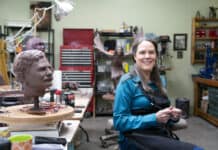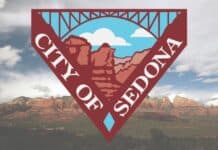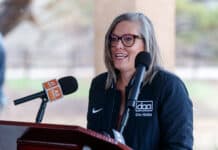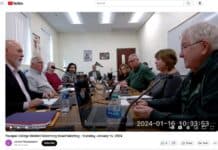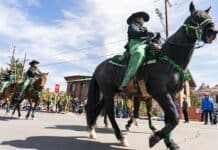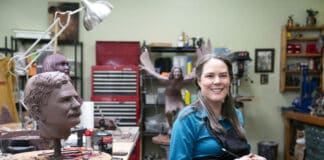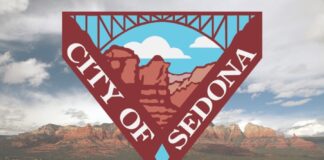Cost and community acceptance were the top two issues at the second meeting of the
Sedona RoadRunner Citizen Review Commission on Tuesday, Sept. 2.
More than $800,000 was spent in fiscal 2008 to run the RoadRunner circulators and express shuttles, with the city of Sedona funding $339,789 of that amount and the remainder coming from state and federal grants which would go to other cities if not used here.
As requested by the commissioners, facilitator Jeff Meilbeck, general manager of NAIPTA, cut to the chase in terms of financial performance, showing actual performance data for the RoadRunner in fiscal 2008, which ended June 30.
By Susan Johnson
Larson Newspapers
Cost and community acceptance were the top two issues at the second meeting of the
Sedona RoadRunner Citizen Review Commission on Tuesday, Sept. 2.
More than $800,000 was spent in fiscal 2008 to run the RoadRunner circulators and express shuttles, with the city of Sedona funding $339,789 of that amount and the remainder coming from state and federal grants which would go to other cities if not used here.
As requested by the commissioners, facilitator Jeff Meilbeck, general manager of NAIPTA, cut to the chase in terms of financial performance, showing actual performance data for the RoadRunner in fiscal 2008, which ended June 30.
His chart showed 94,963 passengers used the service, with the term “passengers” actually meaning boardings, since it’s not practical to count unique customers.
At least half of those boardings were of the same person getting off and on at multiple stops along the circulator route.
For the boardings noted above, 51,943 miles were clocked, with 1.83 boardings per mile at a cost of $13.10 per mile.
The total cost of running the operation for 2008 was $815,198.
Included in those costs are fuel, maintenance, salary packages for three full-time and three part-time drivers, one field supervisor, an operations manager, an assistant operations manager, and twenty percent of Meilbeck’s salary.
The majority of the general manager’s time is spent working on public transportation in Flagstaff, which funds the remaining 80 percent of his salary.
While the circulator fluctuates in usage based on the time of day and the month, the express shuttle has shown steady growth, boarding 800 passengers in August, a record despite little marketing due to concerns about its limited capacity.
In addition to its financial facts, relationships of the users and funders of the RoadRunner were also discussed, as well as who exactly benefits from its availability.
It is visitors who primarily gain from the circulator, able to park and ride all day every day, and it is they who could also be considered the underwriters, since its funding comes from the city’s sales taxes coffers.
Although residents don’t frequently ride the circulator, they could be seen to benefit peripherally if visitors’ cars were taken off the road, thereby reducing pollution, congestion, demand for short-term parking and confusion at intersections and roundabouts.
In addition, if the circulator gave Sedona the reputation for being a visitor-friendly city in combination with pedestrian infrastructure and shopping, it could potentially increase receipts from sales taxes, further benefiting the residents who pay no city property taxes.
Businesses would also gain through additional sales.
Extending the service of the circulator to West Sedona could help to win community acceptance by making it available to residents for car-free trips, including those for shopping, visiting the library, and going to the movies.
On the other hand, without the circulator, residents could benefit from the tax dollars now used for its operation if that money were used in other ways — through improvements or additions to public works, parks and other services.
Commuters using the express shuttle live mostly in Cottonwood and Clarkdale. Some say they save more than $300 per month in gas, minus the cost of the $40 pass.
At least one local hotel purchases passes for their employees, and others reimburse employees who ride the shuttle.
At present, the same vehicles that commute from Cottonwood are used for the circulator, and the commissioners questioned that wisdom.
Some thought the idea of using the eye-catching, gold plated, wooden-seated vehicle at slow speeds in and around the city hauling tourists was positive, but that the same vehicle was inappropriate for high-speed commuting on Highway 89A.
Other criticisms expressed against the current vehicle concerned the confusion caused by the similar model characteristics it shares with the long-established red and green Sedona Trolley, which offers fee-based, hour-long, guided sightseeing tours along with wedding charters and other special events in Sedona and the Verde Valley.
In future meetings, the commissioners will mull whether it’s in the city’s best interests to increase ridership, and if so, how, including the pros and cons of incentives and disincentives for visitors to park and ride, and what the ramifications of those actions might be for residents.
Susan Johnson can be reached at 282-7795, Ext. 129 or e-mail sjohnson@larsonnewspapers.com



